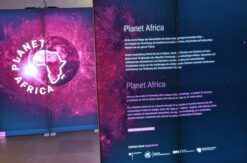E. Razanatsoa drill coring in Madagaskar (photo © P. A. Rasolonjatovo)
Researching pixels and pollen
Africa is an adaptable continent that has always been subject to strong climatic and economic changes – and still is today. From an archaeological perspective, Africa is a hotspot for research into environmental and human history.

The Entangled Africa Programme supports the career of this dedicated young researcher by involving her in the DeGree palaeoecology project, which conducts research on the desiccation of the Sahara and on oasis formation and management in the north of the continent. Estelle Razanatsoa’s expertise in statistical analysis of palaeoecological data will be an important moment for the overall success of the project.

Exploring the history of Africa on the ground is not possible for us at the moment. The global health situation has driven us into home office. And yet we are in the thick of it. From her desk at home and – before the pandemic – through her work on the ground in Sudan, archaeologist Jana Eger is exploring historical sites in the desert and semi-desert areas west of the Nile. With the analysis of remote sensing data, amongst them satellite images and radar measurements, she explored path networks in Sudan for her master’s thesis at the Free University of Berlin. Her current dissertation project takes her back to the country on the Nile – or rather to the savanna and desert areas west of it. As part of the InterLINK project, she is writing her doctoral thesis at University of Münster (WWU) on the the topic of “North Kordofan as a contact and border zone of medieval Nubian states”. This year, due to global travel restrictions, she was able to turn her full attention to the remote sensing data that is fundamental to the InterLINK project’s research. Using high-resolution photos and terrain models, Jana Eger and her colleague Tim Karberg (W.A.D.I.-Project) discovered, for example, previously unknown settlements along the once wet shore zone of a now dry lake near Jebel Nagashush (link to report) on the northern border of North Kordofan. Presumably, these settlements date from between 7000 and 4000 before today. An exact determination will only be possible by visiting the site.
Whether from space or with the computer, the young scientists of the SPP are breaking new ground in the study of Africa – and even a pandemic is not stopping them.






